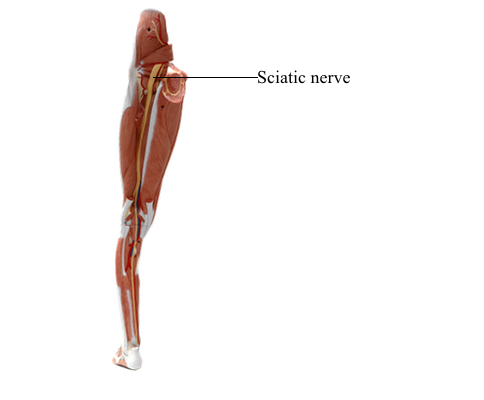Main Model

52 Sciatic nerve

Neurovascular Structures of Gluteal and Posterior Thigh Regions
Several important nerves arise from the sacral plexus and either supply the gluteal region (e.g., superior and inferior gluteal nerves) or pass through it to supply the perineum and thigh (e.g., the pudendal and sciatic nerves, respectively).
Clunial Nerves
The skin of the gluteal region is richly innervated by superior, middle, and inferior clunial nerves (Latin clunes, buttocks). These superficial nerves supply the skin over the iliac crest, between the posterior superior iliac spines, and over the iliac tubercles. Consequently, these nerves are vulnerable to injury when bone is taken from the ilium for grafting.
Deep Gluteal Nerves
The deep gluteal nerves are the superior and inferior gluteal nerves, sciatic nerve, nerve to quadratus femoris, posterior cutaneous nerve of the thigh, nerve to obturator internus, and pudendal nerve. All of these nerves are branches of the sacral plexus and leave the pelvis through the greater sciatic foramen. Except for the superior gluteal nerve, they all emerge inferior to the piriformis.
Sciatic Nerve
The sciatic nerve is the largest nerve in the body and is the continuation of the main part of the sacral plexus. The branches (rami) converge at the inferior border of the piriformis to form the sciatic nerve, a thick, flattened band approximately 2 cm wide. The sciatic nerve is the most lateral structure emerging through the greater sciatic foramen inferior to the piriformis.
Medial to the sciatic nerve are the inferior gluteal nerve and vessels, the internal pudendal vessels, and the pudendal nerve. The sciatic nerve runs inferolaterally under cover of the gluteus maximus, midway between the greater trochanter and ischial tuberosity. The nerve rests on the ischium and then passes posterior to the obturator internus, quadratus femoris, and adductor magnus muscles. The sciatic nerve is so large that it receives a named branch of the inferior gluteal artery, the artery to the sciatic nerve.
The sciatic nerve supplies no structures in the gluteal region. It supplies the posterior thigh muscles, all leg and foot muscles, and the skin of most of the leg and foot. It also supplies the articular branches to all joints of the lower limb. The sciatic nerve is really two nerves, the tibial nerve, derived from anterior (preaxial) divisions of the anterior rami, and the common fibular nerve, derived from posterior (postaxial) divisions of the anterior rami, which are loosely bound together in the same connective tissue sheath.
The tibial and common fibular nerves usually separate in the distal thigh; however, in approximately 12% of people, the nerves separate as they leave the pelvis. In these cases, the tibial nerve passes inferior to the piriformis, and the common fibular nerve pierces this muscle or passes superior to it.